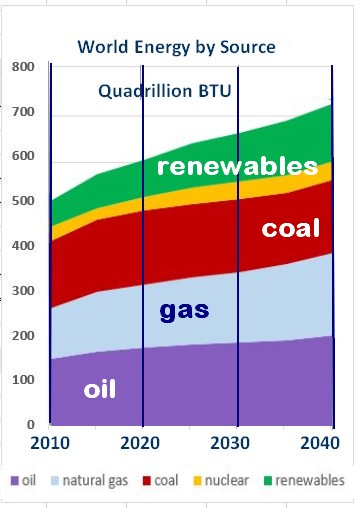APPARENT PROGRESS
& Causes of False Optimism
Jump to: The Dark Truth or Agricultural Collapse and the east China drought of winter / spring 2011, as an trigger for doubling the price of wheat, and contributing to the Arab Spring.
- Agriculture: Theoretically, there is enough food for all, through winter wheat, two growing seasons, GMOs, and industrialized fish, animal & crop farming, higher yields, cricket protein, and more.
- The Paris Climate Accord: Is intended to reduce carbon emmissions and keep global temperature rise below 2 deg C.
- Transitions to Renewable Energy: The goals are more hydro, solar, wind, tidal and geothermal power. Safe nuclear power and future fusion power are being sought aggressively.

Given this “progress”, everything is “fine”, isn’t it? No, it is not.

THE DARK TRUTH
Agriculture:
- Has traded away long-term sustainability for short term excessive output volume, as demanded by population growth.
- Animal Agriculture has a huge carbon footprint.
- Excess food output levels are dependent on fertilizers,
which create ocean dead zones.
.
- Conversion of forest to cropland (for animal feed, palm oil, …)
expands erosion and loss of topsoil quality. - Animal antibiotics are rendering medicines useless.
- Overfishing continues. Aquaculture is half of all seafood.
- Drought and floods are destroying food supplies.
World agricultural capacity is about to implode, catastrophically, within decades, not centuries.
Jump to: Agricultural Collapse

Climate Change:
- Is roaring forward, due to higher population, greater fossil fuel
energy use, higher CO2 emissions.
- The Paris climate agreement has no means of enforcement.
- Carbon giants: the US has withdrawn and China’s goals in the
Paris agreement are underwhelming.
- Temperatures continue to rise unabated, and
- Massively destructive storms have doubled this century.
Renewable Energy is a small fraction of world demand:
| Update for 2015 and 2040 Projection. . . Solar, hydro and wind today remain less than 10% of world energy production and will remain only 17% of the total by 2040, per US Energy eia – energy information association projections . . Fossil fuel use grows, not slows… The flat coal projection is hard to believe. There are massive coal reserves in China, India and Indonesia, countries which have huge energy demands. |
eia projections
|
- Almost 3 billion persons still cook over open fires, and
- There is enough coal available to burn for 1,000 + years.
- Population growth continues to drive energy and resource usage.
The use of fossil fuels is increasing, not slowing down..
TODAY’S SOLUTIONS ARE GROSSLY INADEQUATE
Without a massive shift in awareness and rapid new actions, Planet Earth is pretty much doomed by the year 2100. That date is well within our children's lifetimes. The Solutions proposed here are not radical; they are necessary.
Agricultural Collapse
 |
Liuebig’s Barrel The lowest barrel stave determines the height of the water |
Agricultural output follows the same principle: The most scarce resource determines the crop output. No amount of fertilizer will grow more plants, if there is not enough water. And vice versa. Farming is a risky business. Fungus, insects, tough weeds, heat, hail or excess water can also ruin a harvest.
The most likely cause of agricultural collapse will be a few decades of drought in the bread baskets of the world, sufficient to drain the world’s aquifers. Staggered occurences of only a few years of drought can have the same effect. Visit the page on Water Scarcity, to see massive world aquifer losses to date. These patterns are emerging and may be well established as early as 2030. Here is an example:
Impact of the East China Drought of 2011:
Highlights from an abstract at Science Direct. Article: “Chinese drought, bread and the Arab Spring”, by Troy Sternberg, 2012:
► (Subject) “China’s eastern agricultural experienced extreme drought
in winter 2010 / spring 2011.
► Chinese drought contributed to a doubling of global wheat prices.
► The drought affected the price of bread in Egypt which (tripled), influencing political protest,” (and adding momentum to the Arab Spring)
…(most severe drought ever recorded in China, per Wikipedia)
From Wikipedia, on the east China drought of 2011:
20% of the farmland (in east China) and 35% of the entire wheat crop was impacted. By February 2011, the drought hit a total of up to 19,100,000 acres of winter wheat.

Recent Extreme Droughts
- northern china, 2010 – 2011
- northern china, 2017
- california, 2010 – 2016
- most of argentina, 2018
. - texas panhandle and surrounding region, continuous
- south saharan africa, continous
- saudi arabia, pakistan, iran, syria, somalia, on-going
- central and eastern russia, east and south india, bangladesh
. - north west central america, south africa,
- central canada and central united states
- south east and south west australia
- germany, 2018; inland shipping reduction and 25% drop in wheat yield; reveal of the middle ages “hunger stones”
- this is a long list …
More information on world droughts is available at The Watchers


